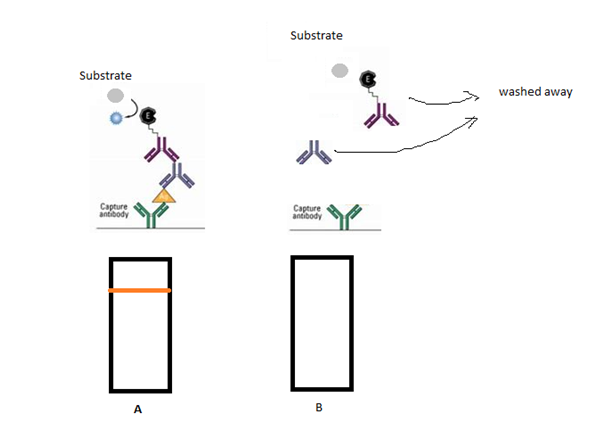ELISA (Enzyme-Linked Immunosorbent Assay) is a powerful laboratory technique used to detect and quantify proteins, antibodies, and antigens. It is widely used for diagnosing infectious diseases caused by bacteria, viruses, and parasites. The method is favored for its sensitivity, specificity, and ability to process multiple samples simultaneously.
Table of Contents
Principle of ELISA
ELISA involves the following basic steps:
- Coating: A plate is coated with an antigen or antibody specific to the target pathogen.
- Blocking: Any unoccupied sites on the plate are blocked to prevent non-specific binding.
- Sample Addition: The sample (serum or plasma) is added. If the target antibodies or antigens are present, they will bind to the coated surface.
- Detection: A secondary antibody, which is enzyme-linked and specific to the target, is added. This binds to the primary antibody or antigen.
- Substrate Addition: A substrate for the enzyme is added. The enzyme catalyzes a reaction that produces a measurable signal, often a colour change.
- Measurement: The intensity of the signal is measured, usually using a spectrophotometer, which correlates to the concentration of the target in the sample.
Types of ELISA
- Direct ELISA: Detects antigens directly from samples.
- Indirect ELISA: Detects antibodies in the sample.
- Sandwich ELISA: Uses two antibodies to capture and detect antigens.
- Competitive ELISA: Measures the concentration of an antigen by observing competition between the sample antigen and a labelled antigen.
Diagnosis of Disease by ELISA
- Bacterial Diseases
- Common Bacterial Pathogens: Escherichia coli, Staphylococcus aureus, Salmonella, etc.
- ELISA Application:
- Used to detect bacterial antigens in clinical samples (e.g., stool, blood).
- Indirect ELISA can be employed to measure antibodies against specific bacteria in serum, helping diagnose infections like typhoid fever or infections by Helicobacter pylori.
- Advantages: Quick results, high specificity.
- Viral Diseases
- Common Viral Pathogens: HIV, Hepatitis B and C, Influenza, etc.
- ELISA Application:
- Direct ELISA for detecting viral antigens (e.g., HIV p24 antigen).
- Indirect ELISA for measuring antibodies against viruses (e.g., antibodies to Hepatitis B surface antigen).
- Advantages: Sensitive detection of early infections; can also be used for monitoring treatment efficacy.
- Parasitic Diseases
- Common Parasitic Pathogens: Plasmodium spp. (malaria), Giardia lamblia, Toxoplasma gondii, etc.
- ELISA Application:
- Detection of parasite antigens in serum or other bodily fluids.
- Measurement of antibodies to parasites, useful for diseases like malaria or toxoplasmosis.
- Advantages: Non-invasive; can be used for seroprevalence studies in populations.

Advantage and limitation of ELISA
- Advantage of ELISA
- Sensitivity and Specificity: High accuracy in detecting target molecules.
- Quantitative and Qualitative Results: Provides data on both presence and concentration.
- Versatility: Can be adapted for various types of pathogens.
- High Throughput: Multiple samples can be processed simultaneously, making it suitable for large-
- scale testing.
- Limitation of ELISA
- False Positives/Negatives: Can occur due to cross-reactivity or inadequate sample processing.
- Technical Expertise Required: Proper technique is crucial for accurate results.
- Cost: Initial setup and reagent costs can be high.
Conclusion
ELISA is a cornerstone diagnostic tool in clinical microbiology, providing essential information for the diagnosis of bacterial, viral, and parasitic diseases. Its ability to quickly and accurately detect pathogens makes it invaluable for patient management and public health surveillance. Continuous advancements in ELISA technology promise further improvements in its diagnostic capabilities and applications.
You can also read